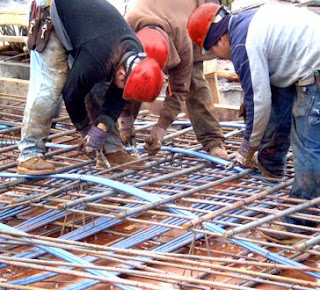SPONSORED
Post-tensioning is a process of reinforcing and prestressing concrete. Stresses are brought into the concrete using bars or strands of steel while it is being constructed. The strands of steel are typically used in horizontal construction such as foundations and beams. Steel bars are used for vertical purposes such as columns and walls.
Typical steel strands used in post-tensioning have a tensile strength of 270,000 pounds/in². In comparison, a typical non-prestressed piece of reinforcing has a tensile strength of 60,000 psi. Strands typically have a diameter of 1/2 in., and are stressed to a force of 33,000 pounds. The stresses brought into the concrete offset the expected external loads the concrete will be subjected to.
In post-tensioning the steel is held in a duct, which stops the steel and concrete from binding after the concrete solidifies. The steel can then be stressed after the concrete sets. This is usually done in two stages. The first prestress applied is up to 50% of the final force and this is done when the compressive strength reaches 12-15N/mm².
The second stage is when the final stressing occurs and this is done when the concrete meets its design strength. The strands and bars are tensioned by stretching them with a hydraulic jack. They are then fixed in place with an anchoring component, which holds the force in them for the life of the building. Post-tensioning allows the engineer to have all the benefits of using prestressed concrete while keeping the freedom of constructing on site.
Concrete is very strong in compression and weak in tension. Steel however is very strong in tension. By combining the two materials we create a component, which is strong in both tension and compression. More benefits can be found by using the steel to place the concrete into compression. This increases it's tensile strength, which allows for longer spans and thinner sections. It also helps to stop the formation of shrinkage cracks, which in turn stops moisture passing through the material.
The more the concrete is compressed, the less likely it is that cracking will occur. Using post-tensioned concrete allows for flexible column spacing and structural depth.
In post-tensioning the steel is held in a duct, which stops the steel and concrete from binding after the concrete solidifies. The steel can then be stressed after the concrete sets. This is usually done in two stages. The first prestress applied is up to 50% of the final force and this is done when the compressive strength reaches 12-15N/mm².
The second stage is when the final stressing occurs and this is done when the concrete meets its design strength. The strands and bars are tensioned by stretching them with a hydraulic jack. They are then fixed in place with an anchoring component, which holds the force in them for the life of the building. Post-tensioning allows the engineer to have all the benefits of using prestressed concrete while keeping the freedom of constructing on site.
Concrete is very strong in compression and weak in tension. Steel however is very strong in tension. By combining the two materials we create a component, which is strong in both tension and compression. More benefits can be found by using the steel to place the concrete into compression. This increases it's tensile strength, which allows for longer spans and thinner sections. It also helps to stop the formation of shrinkage cracks, which in turn stops moisture passing through the material.
The more the concrete is compressed, the less likely it is that cracking will occur. Using post-tensioned concrete allows for flexible column spacing and structural depth.




